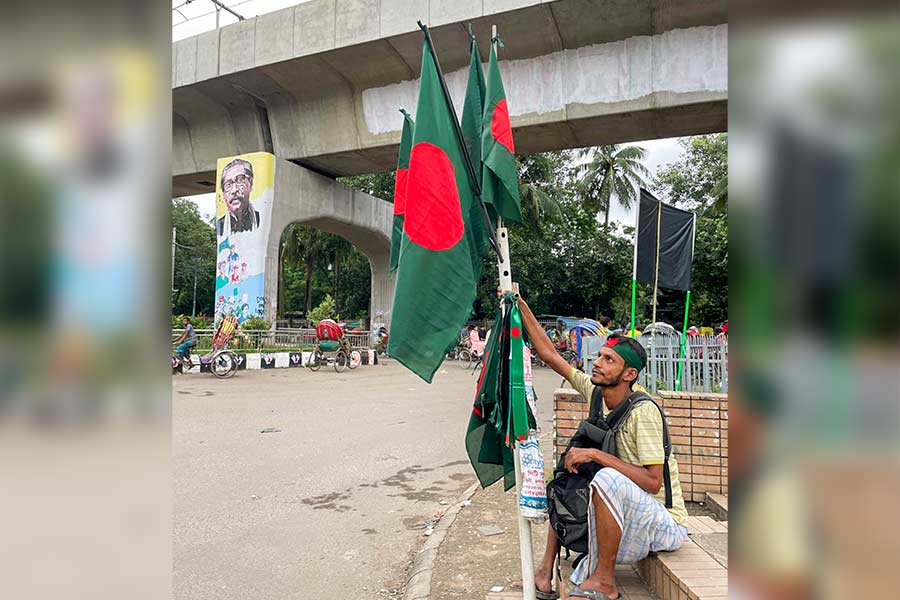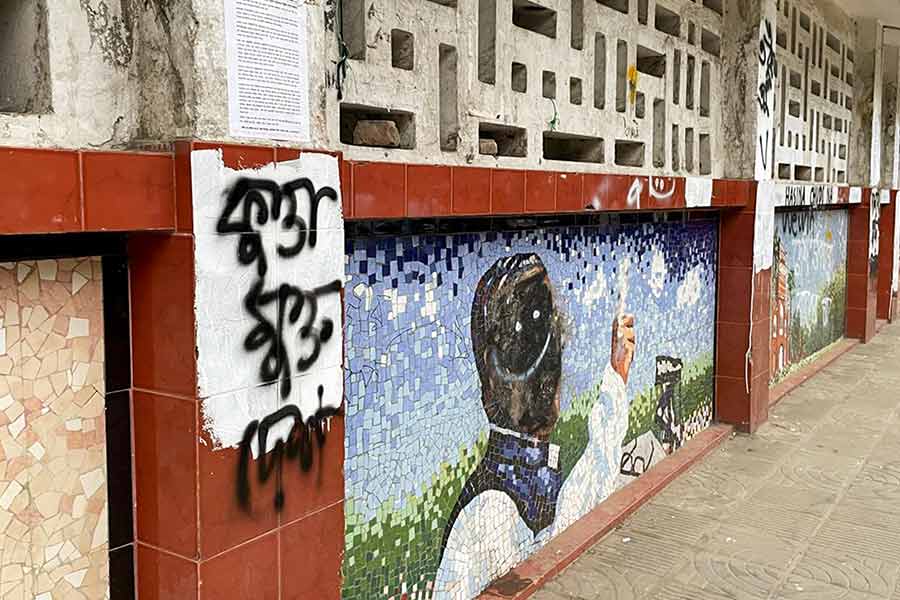When a popular uprising in Bangladesh brought down the Sheikh Hasina-led government, college student Alif Hossain felt the deposed prime minister got what she deserved, but the toppling of the Dhaka statue of Sheikh Mujibur Rahman by protesters on August 5 left him deeply disturbed.
"It was just wrong. He fought for the liberation of our country, he is the Father of the Nation, our Bangabandhu, how could he be so disgraced in the fit of anger," the Dhaka-based student rued.
The legacy of Rahman or Mujib, as he was popularly called, lives on in the names of streets, institutions, public landmarks, his fiery speeches made during the struggle for independence, the face of Bangladeshi currency, and till recently in statues and murals.

A defaced mosaic art depicting first president of Bangladesh Sheikh Mujibur Rahman on a wall of the building of the Teacher Student Centre (TSC) of the Dhaka University, Friday, Aug. 23, 2024. PTI
The unprecedented protests precipitated the fall of the previous government as Hasina fled to India on August 5 leaving behind a country in political turmoil.
In the wake of her departure, she courted even more public opprobrium, and her father's legacy too became a prime target as anti-government protesters vented their ire on Rahman's towering statue at Bijoy Sarani in the heart of Dhaka and pulled it down, with images being broadcast on local and international media channels.
Public murals depicting Bangabandhu ('Friend of Bengal') -- a sobriquet that characterised the legacy of Bangladesh's first president -- were defaced, and his house in Dhanmondi where he and most of his family members were assassinated on August 15, 1975 and which was later turned into a memorial, was badly damaged by protesters.

A flag seller sits at the periphery of the Raju Memorial opposite the Teacher Student Centre (TSC) of the Dhaka University as a defaced mural of first president of Bangladesh Sheikh Mujibur Rahman is seen on a metro pier in the background, Monday, Aug. 19, 2024. PTI
In the Dhaka University area, a series of wall panels on the front side of the building of the famous Teacher Student Centre (TSC) bears old mosaic panels depicting legendary personalities and historic moments like the signing of the Instrument of Surrender of Pakistani forces in Dhaka on December 16, 1971, which led to the birth of the new nation of Bangladesh.
The mosaic panel depicting Rahman has been defaced, his face blackened.
On the Dhaka University campus, a huge mural on a wall depicting Bangabandhu was defaced with graffiti scrawled all over the artwork.
Many artworks made on public walls in the university area after August 5 mock Hasina and her fleeing to India and extol the public resistance culminating in what many Bangladeshi now call the 'Victory Day' of '36 July'.
From being revered by countrymen to his images and memorials being disgraced, Rahman's legacy is now much contested in the post-upheaval society of Bangladesh.
The 'Gen Z' as the young protesters are being labelled by many, were born after the Liberation War of 1971, and political observers say their idea of Bangladesh is "different" from what the pre-1971 generations may have had.
Hasina, 76, resigned as the prime minister on August 5 amid mass protests against her government. The protests, which started last month initially with a demand to end the quota system that reserved 30 per cent of government jobs for the families of veterans who fought in Bangladesh's War of Independence against Pakistan in 1971, later turned into anti-government demonstrations.
Abdul Moyeen Khan, a senior leader of the Bangladesh Nationalist Party (BNP) and a former Cabinet minister of Bangladesh criticised Hasina and accused her of "destroying" the several institutions of the country which resulted in this "revolt by students" that was later supported by the general masses.
"If she was a real leader, she wouldn't have led the country to drive to that stage," Khan told PTI in an interview in Dhaka on Thursday.
Asked if the denigration of Rahman's legacy is undermining the 1971 liberation war, he said, "No".
"It is a continuous process, you have to formulate and reformulate, the human society doesn't remain static at any place. It (recent movement) is not undermining anything," Khan said.
But, a section of Bangladeshis feels a palpable fear that "Mujib's legacy may be slowly erased or whittled down", an argument countered by pro-protesters who claim that "he was given undue space in history by the Awami League government" and "many controversial facets of his life have not been told to people".

A defaced mosaic art depicting first president of Bangladesh Sheikh Mujibur Rahman on a wall of the building of the Teacher Student Centre (TSC) of the Dhaka University, Friday, Aug. 23, 2024. PTI
Alif Hossain, who studies at a college in Dhaka, however, pleads for a "more mature" approach to looking at history.
"In retrospect, we cannot go back and start attacking Mujibur Rahman's legacy. History should not be erased even if it is contested. His daughter (Sheikh Hasina) did wrong things and faced consequences. But, toppling statues and defacing Bangabandhu's murals is just plain wrong," he told PTI here.
Opposite the TSC is the famous Raju Memorial -- an iconic sculpture mounted on a raised platform -- located in a traffic roundabout that faces the Suhrawardy Udyan, a national memorial which marks the spot where Rahman had delivered the historic March 7, 1971 speech during the independence struggle.
On two Dhaka Metro piers, one on each side of the Raju Memorial, huge murals of Rahman and Hasina were earlier painted. During the agitation, both artworks were defaced by anti-government protesters, and still stand sullied, making a visible dent in Mujib's legacy in Dhaka.
The Bangabandhu National Stadium, Bangabandhu Sheikh Mujibur Rahman Novo Theatre, and the Bangabandhu Avenue in Dhaka, all carry the name of the founding father of Bangladesh.
Bangabandhu Sheikh Mujibur Rahman Novo Theatre, inaugurated in September 2004, was established as a non-formal science educational institution to "eradicate superstitions and blind faith from the society and to inculcate positive scientific temper in the mind of people, especially among the students", reads a description on its website.
The headquarters of the Awami League is located on Bangabandhu Avenue. The party, formed in 1949, under Rahman had led the struggle for independence of Bangladesh. Its offices were also targeted by anti-government protesters recently.
Rahman was born in 1920 in undivided India. Bangladesh evolved from Bengal presidency to East Bengal to East Pakistan and eventually as a separate nation born in 1971.
According to a profile of Rahman on the Dhaka University website, "he is regarded as 'Jatir Janak' or 'Jatir Pita' (both meaning 'Father of the Nation') of Bangladesh.
The then Hasina government had marked his birth centenary by declaring 2020-21 as 'Mujib Year'.
In the highly charged environment that Bangladesh is in right now on the back of anti-government protests, there is an element of uncertainty around the future of Mujib's legacy, but his legend shall live on.
Except for the headline, this story has not been edited by The Telegraph Online staff and has been published from a syndicated feed.











